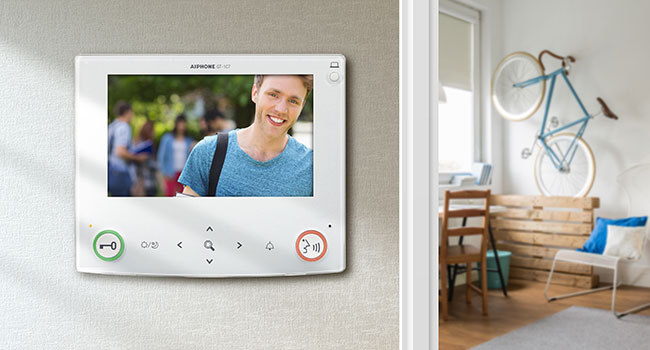
Integrators Look at Video Intercoms
- By Bruce Czerwinski
- Apr 01, 2018
System integrators count on video intercoms to secure virtually
any facility, whether it’s a remote water pump station,
a pharmaceutical manufacturing plant or a multitenant
apartment building. Intercoms add a valuable layer
of security by letting employees or residents control who
enters their facilities.
Three veteran integrators recently shared why they see video intercoms
as an important security tool they turn to often.
Don Beres, senior physical security specialist for Fremont,
Calif.-based Ojo Technology, said he regularly installs video intercoms
in the vertical markets his company serves: education, transportation
and public facilities such as police departments, city halls
and water districts.
“In the past 12 to 18 months, virtually every one of our new projects
had a video intercom specified in the plans,” Beres said. “When
we present an access control solution, we nearly always include a
video intercom in the proposal. They’re reasonably priced and add
another camera that provides a view of the entry and people in the
immediate area.”
When Beres started in the security industry in 1979, he installed
audio-only intercoms. He said he still installs a few of those units,
but video intercoms have become the standard. Customers like the
added sense of security that comes with seeing visitors wanting to
enter a building.
And, Beres said, intercoms are not limited to just the front door.
Ojo installs them at delivery bays and employee entrances, as well at
inside doors to sensitive operations such as IT and cash rooms.
He said the introduction of IP-based video intercoms opened up
new markets for Ojo. One example was a remote, unmanned water
district pump station. Only a few years ago a district employee would
have to drive to the site to open the vehicle gate for contractors. Now,
with a networked video intercom in place, a district employee can
remotely unlock the gate. That saves the district time and money.
Jason Beardsley, managing partner of Security 101—San Diego,
agreed with Beres that video intercoms have become nearly universal
in commercial applications. Beardsley estimates at least 90 percent of
his projects include one or more video intercoms.
Security 101—San Diego recently installed systems for a Class A
pharmaceutical manufacturer looking to limit unapproved visitors to
its engineering and manufacturing facility. Master stations were placed
on the desks of receptionists on the building’s first and second-floors.
Intercoms were also installed at the shipping and receiving dock and
some sealed interior areas open to only approved employees.
“This company has covered the mission-critical points of the facility
with intercoms,” Beardsley said.
He said he recalls intercoms of more than 20 years ago being basic
door-release systems, but many of today’s IP-based systems integrate
with existing CCTV cameras and connect to a VMS to record events.
“Video intercoms have become a relatively inexpensive, yet vital,
part of an overall security system,” Beardsley said. “Customers are
well educated about the technology and are asking for it more often.”
The integrator also installs video intercoms embedded in emergency
towers for use on college and hospital campuses and in large
municipal parking facilities. Beardsley said the stations offer people
an immediate connection to campus security or police. Dispatchers
can identify the exact location of the station and the tower’s camera
provides views of the area, useful in determining a proper response.
He said his staff installed emergency towers on five campuses in 2017
and already has three on the books for this year.
Multi-family apartment buildings and co-ops are the focus for
Dan Arnold, vice president of Hicksville, N.Y.-based Academy Mailbox.
His family-owned business has been installing intercoms in
hundreds of residential buildings in the metropolitan New York City
area since 1948.
When Academy began business 70 years ago, its employees were
installing what were known as bell-buzzer intercoms. They were little
more than a doorbell that would ring in a selected apartment. Residents
would push buttons in their apartments to buzz in visitors. There
was no voice or video communication between the visitor and tenant.
“The first audio-only intercoms designed for apartment buildings
came along in the 1960s,” he said. “Black-and-white video intercoms
reached the market 20 years later and color units in the late 1990s.
With the added video, we were able to do a much better job of keeping
people safe in their apartments.”
While many New York buildings have part- or full-time doormen
to screen visitors, many building managers are questioning if it makes
sense to continue the practice. Arnold said the trend is toward providing
residents with a video intercom to let them make their own
decisions about who gets in.
“Depending on the size of the building and the cost of the doorman,
a system could pay for itself in less than a year, especially if
there is useable wiring already in place,” said Arnold. “Much of the
building wiring installed for the first wave of video intercoms in the
1980s and 1990s is still good and can save tens of thousands of dollars
in installation costs.”
He said Academy also installs door stations on secondary entries,
including those used by delivery services and maintenance people.
Another trend in multi-family building security is the use of entry
vestibules. Arnold said one intercom mounted outside is used to call
residents. Once inside the first door, they need to call again to gain
entry into the lobby. This gives residents a chance to see the visitor
isn’t letting an unapproved person enter at the same time.
These integrators agreed video intercoms add a vital layer of protection
to any security plan and the importance of intercoms has
grown as they’ve progressed from basic doorbells to today’s networkbased
security platforms.
This article originally appeared in the April 2018 issue of Security Today.